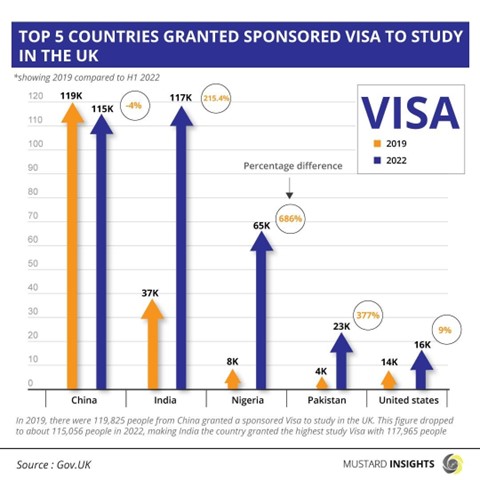By 2021/2022, the Higher Education Statistics Agency (HESA) reports that as many as 480,000 international students will receive sponsorship visas to the United Kingdom.

The United Kingdom has long been a favourite destination to study for international students. The large number of universities, variety of courses offered, and uniformity of language has led students from other parts of the world to seek higher education in the British Isles. After all, the common language, English, is most likely to be the second language of most people of non-British lineage.
Another reason for the country’s popularity is the possibility of remaining in the country to live or work after completing studies. This attracts Asian and African students, who may see undertaking an educational program as a pathway to long-term emigration. This, however, was affected by the decision of former Home Secretary and eventual Prime Minister, Theresa May, to scrap the popular Graduate Route visa in 2012. The Graduate Route visa allowed students who had undertaken an undergraduate or Masters-level postgraduate program to remain in the country for two years post-graduation.
The scrapping of this route by Ms. May inevitably led to the decline in the number of international students coming into the country. The United Kingdom’s loss turned out to be the gain of countries like Australia and Canada, as the eyes of students turned that way instead. While the policy was suboptimal for UK universities, many depend on significant foreign fees; it was particularly disastrous for the labour availability in highly-skilled STEM fields (science, technology, engineering, and maths). Numbers from 2012/2013 showed that 50% of UK maths students and 43% of engineering/tech students were from non-UK/EU countries.
Policies by the number
The decision by then-Prime Minister Boris Johnson to revise Ms May’s policies and bring back the two-year-Graduate Route visa in 2019 has shown near-instantaneous results. The policy came into effect in the 2019/2020 academic session. Since then, international student numbers from most countries have shot up.
In 2018/2019, the last year without the Graduate Route option, non-UK/EU students in the United Kingdom totalled 342,620. By 2021/2022, the Higher Education Statistics Agency (HESA) reports that as many as 480,000 international students will receive sponsorship visas. This shows a near-40% increase on 2019’s numbers, with international students in the UK totalling well over 610,000 from 2018/2019’s 496,110 figure. This figure already surpasses the United Kingdom’s target of 600,000 international students, as outlined by the country’s 2019 International Education Strategy.
A few countries have shown sharp increases, with the graphic above showing 215%, 686%, and 377% rises in students from India, Nigeria, and Pakistan, respectively. Countries like Saudi Arabia, Malaysia, and Hong Kong have also increased, with Chinese numbers dropping slightly, likely due to SARS-Cov-2 travel restrictions.
Will the trajectory continue?
It remains to be seen how the present United Kingdom government will impact the visa policy, but early signs show that there will be no interference in the current system.
Despite the recent remarks by the Home Secretary about limiting dependants and revisiting the visa routes, the number of international applications to United Kingdom universities is expected to stay on its present growth trajectory.
Thoughts?
We won't share your email address. All fields are required.
